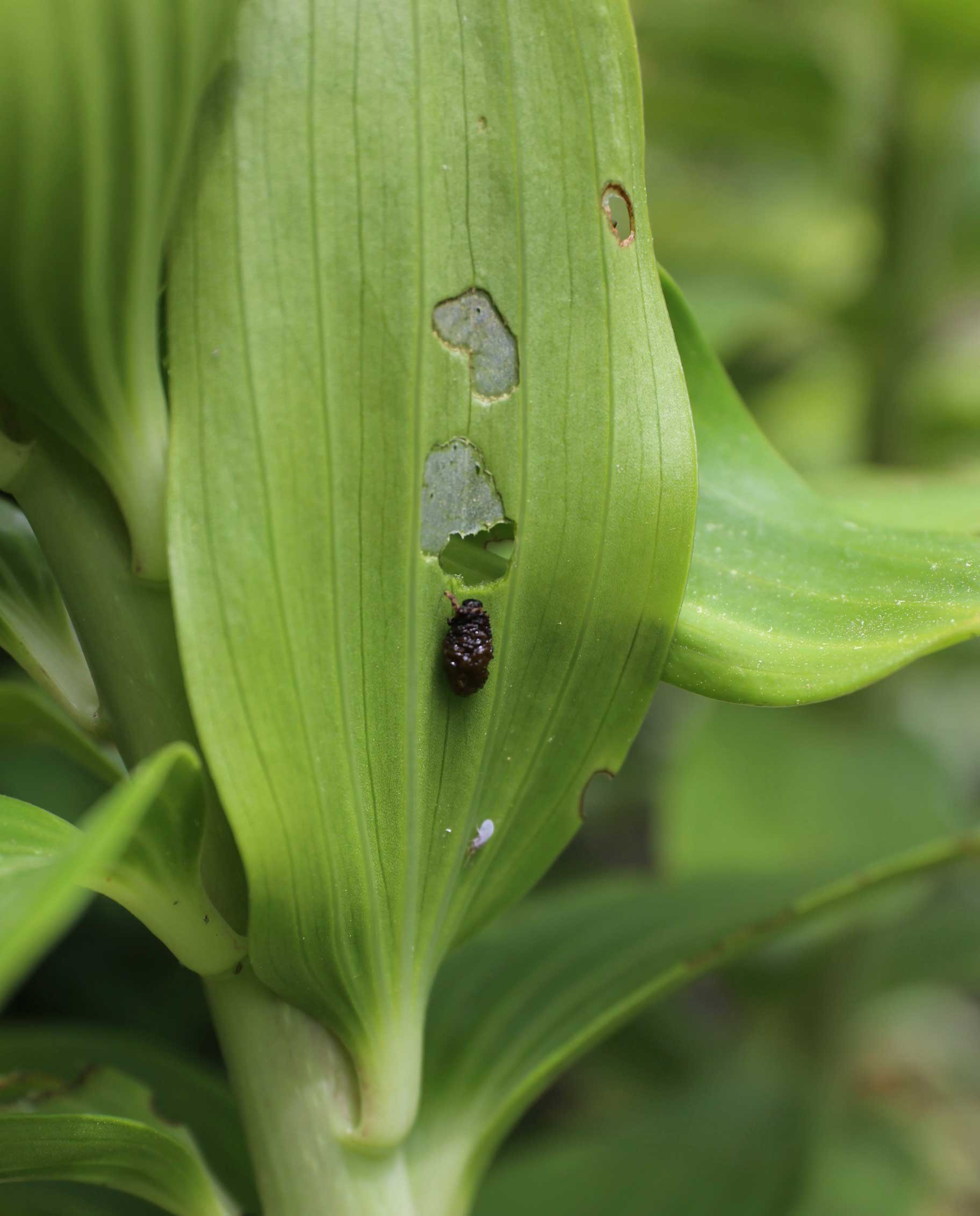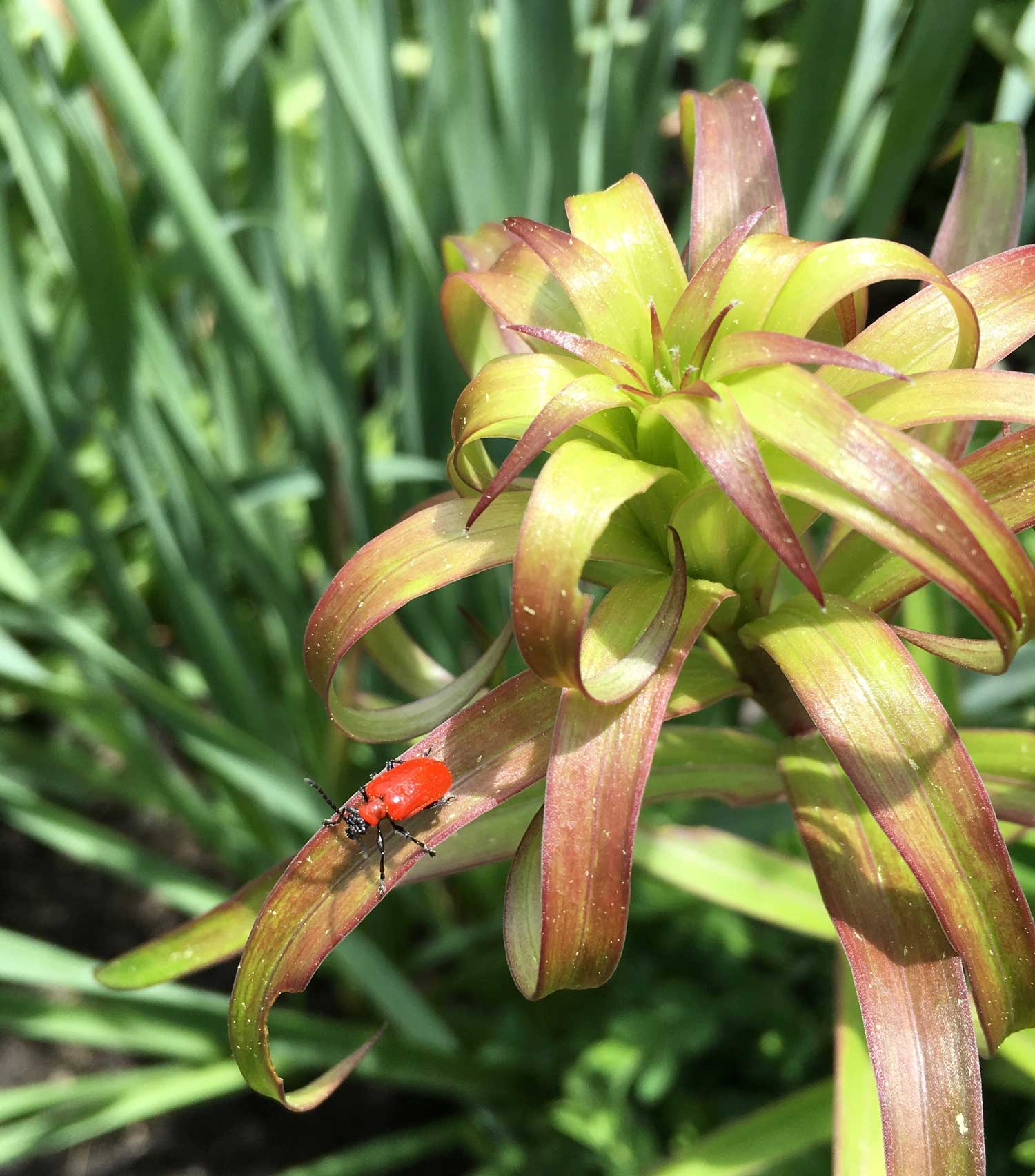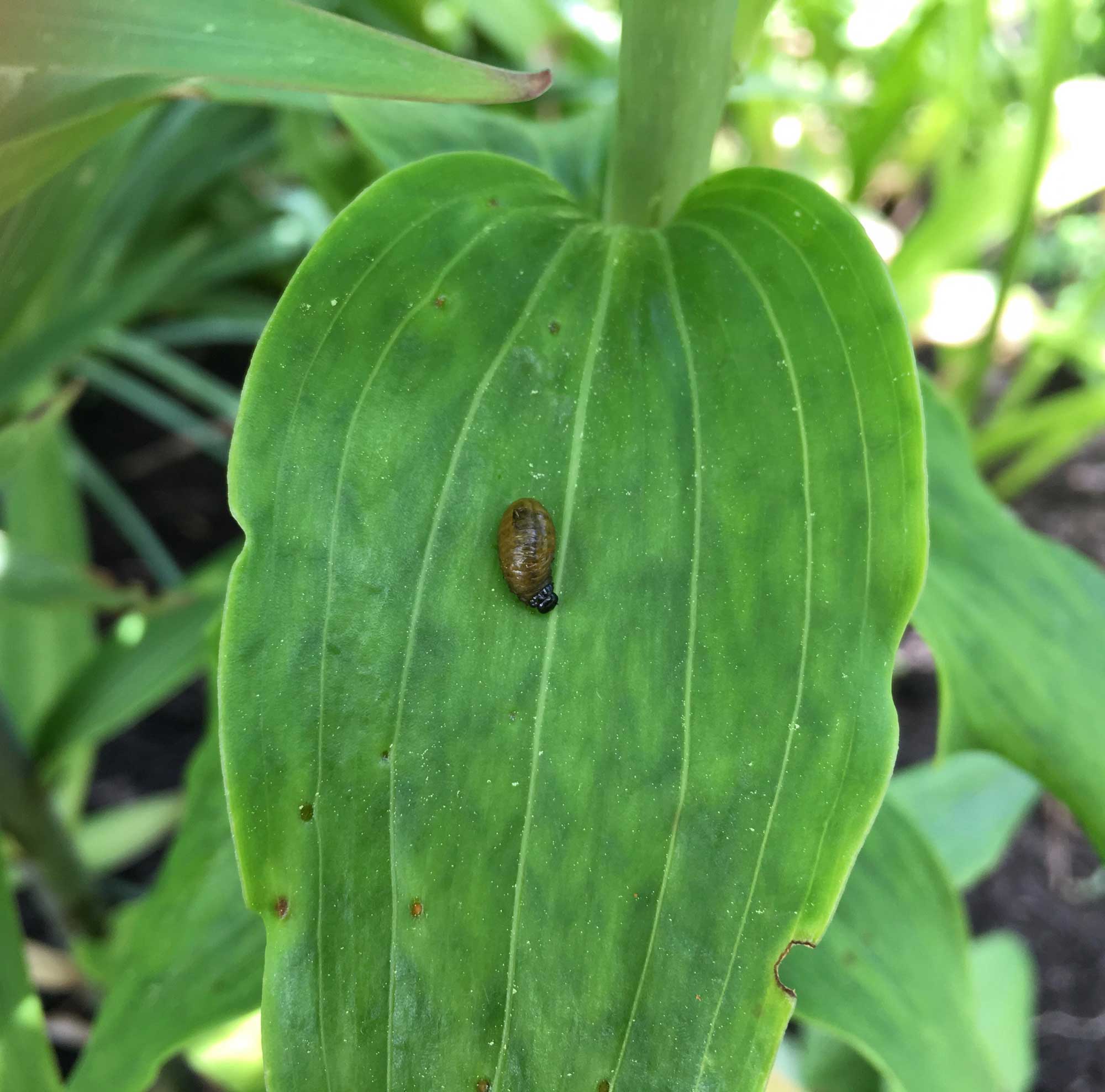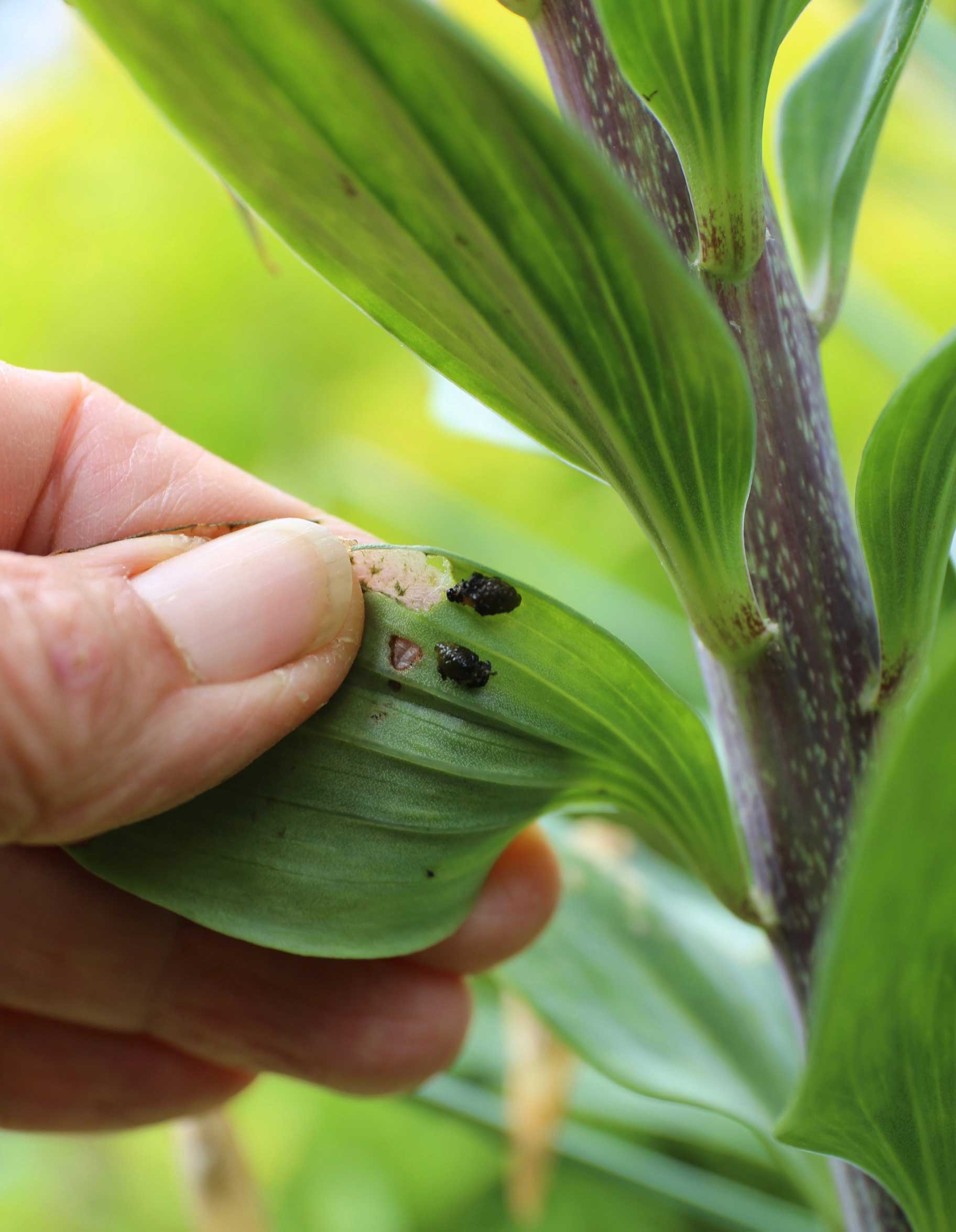How to Control Red Lily Leaf Beetles
The red lily leaf beetle (Lilioceris lilii) is a destructive pest that feeds almost exclusively on true lilies (Lilium spp.), including Asiatic and Oriental lilies as well as Orienpets and species lilies.
First discovered in Canada about 50 years ago, this non-native species has gradually infiltrated most of New England and central and western Canada. In 2012 it appeared in Washington and Oregon as well. If this pest is active in your region, your lilies are at risk. Here are some ways to protect them.
The lily leaf beetle is about ¼” long and bright, scarlet red. Though easy to see, they are fast and difficult to catch. If they sense you approaching, they immediately drop to the ground on their backs and quickly vanish into the soil.
There is one generation of these beetles per year. Adults overwinter in the soil and emerge in April and May to begin feeding and laying eggs. Each female can lay up to 450 eggs over a period of 3 to 4 weeks. The tiny, orange-brown eggs are laid in rows on the underside of lily leaves and the larvae begin hatching one to two weeks later.
Lily leaf beetle larvae are soft and slug-like. They’re not pretty, but it gets worse. To protect themselves, they carry their excrement on their backs (shown below). Ingenious and super disgusting.
The larvae are voracious eaters and feed for 3 to 4 weeks before moving down into the soil to pupate. About a month later they emerge as adult beetles and continue feeding before they return to the soil for the winter.

WHAT TO DO
Most plants can generate new growth if their foliage gets eaten, but that’s not the case with lilies. If lily leaf beetles eat the leaves, that’s it for the season and the plants may not have enough energy to return the next year. This makes it very important to prevent their damage.
Handpicking. Start scouting for lily beetles in late spring, shortly after your lilies emerge from the ground. You’ll need to sneak up and be prepared to grab them very quickly. Drop into hot soapy water or use force to crush their shells. Inspect stems and leaves from all angles as the beetles hide in leaf crotches.
Destroying this pest’s eggs and larvae is equally important. Check your plants carefully at least twice a week, taking time to bend down and look under every leaf. Scrape off the larvae and remove the eggs — wearing tight-fitting rubber gloves makes this job a little easier.
Spraying. There are two organic sprays that are relatively effective against the red lily leaf beetle. For both, spray coverage must be heavy and complete. Neem, an extract of the neem tree (Azadirachta indica), will kill young larvae. It should be applied every 5-7 days throughout early summer.
Spinosad, an insecticide made from soil bacteria, is also effective if applied weekly. As with all insecticides, it’s important to spray in the evening when bees are not foraging. Avoid spraying in windy weather when the spray may drift onto nearby flowers.
In Europe, parasitic wasps keep lily leaf beetle populations in check. Scientists at the University of Rhode Island have released several species of these predators in RI, MA, NH and ME. Over time, lily leaf beetle populations have declined in most of the test areas and the wasps are gradually spreading into neighboring towns. Hopefully this ecological approach will put a dent in the problem.
Resistant Varieties
Some types of lilies are proving to be more resistant to lily leaf beetles than others. Research at the University of Maine found Lilium henryii ‘Madame Butterfly’, Lilium speciosum ‘Uchida’ and Lilium ‘Black Beauty’ (shown above) show better than average resistance.
If you live in an area where the lily leaf beetle is a problem, don’t despair. A combination of hand-picking and spraying the foliage weekly for the first half of the summer will keep this pest under control and let you continue to enjoy the beauty and fragrance of lilies. We offer many types of lilies, including Asiatic lilies, Oriental lilies, Oriental trumpet lilies and species lilies.
To learn more about growing lilies, read All About Lilies, Bloom Times for Lilies and How to Plant Lilies.






Hello. I uprooted all lilies in 2 flower beds before last winter and also scooped up a couple of inches of soil and discarded this as well since I was hoping to start over in the two flower beds after noticing total devastation of my backyard lilies last summer. I have seen a couple of the red lily beetles in each bed now and destroyed what I found in warm soapy water, including dropping soil in there from the immediate area. In one bed, there are only tulips coming up, or so I believe and in the other, just ground cover. I don’t see any evidence of chomping in either case. My question is this… If I plant a couple of rose bushes in the one bed, and dahlia bulbs in the other (which I’ve had success with over the years) will the lily beetles feast on either? Or will they simply die or go elsewhere? I have beautiful lilies at the front of the house as well and don’t want the beetles transferred there. I also have Lily of the Valley on the side of the house. I work full time and can’t go into the garden several times a week on a bug seek and destroy mission. Do you have any suggestions for me?
Hi Judith, Sorry to hear you are having lily beetle trouble. They are nasty pests! You don’t need to worry about your other perennials and roses. Lily leaf beetles are selective and they only eat plants that are in the Lilium family.
To protect the lilies at the front of your house, you should watch carefully for the beetles and destroy them as soon as you find them — before they can reproduce. As long as you grow lilies, your plants will be susceptible to beetle damage. Even if you eradicate them from your garden, they can eventually come in from someone else’s garden. In my experience, staying on top of them in May and early June means very few problems later on. Good luck!
Lily buds destroyed overnight. Next morning, saw black round beetle on the stem that was left. Is this still a leaf beetle? I did not see red beetles, just this black round one. Was that the beetle carrying his poop on his back, or are there other varieties of beetles that attack and chomp down on lilies? Lilies already in beautiful big blooms not affected. Thank you!
It’s the nymphs that carry their excrement on their backs. They are the juvenile stage of the beetles and are soft-bodied and pale orange in color. They look nothing like a beetle. In my experience, lily leaf beetles usually prefer the foliage over the buds. I don’t know about other types of beetles that eat lilies. Glad you still have some nice ones left!
Can I use borax or Epsom salt around my lillies to kill the Red Lilly Beetles off. Also would Malathan hurt the plant. I can get it in the US. Thanks
Hi Janet. I don’t think borax or Espsom salt will have any effect on the beetles. We recommend using organic pest controls and even then, taking great care to protect bees and other pollinators. I don’t know anything about Malathion other than it’s not considered organic. So you’ll need to refer to the label.
2017- my first Spring in new home. Was shocked to see what seemed like an infestation of lily beetles being born. They hung out on my hose, around the walkway, along edge of lawn. Thousands.
I don’t normally grow true lilies but there was one the previous owner planted. I plan to dig it out after it blooms … which they are not eating, but are in the mulch and surrounding lawn. I squish as I can and I’ve sprayed neem oil and Dead Bug (contains Spinosad). Neither seem to affect adults. Is that correct?
What can I do this fall to discourage overwintering here again? The one lily plant will have been removed. What draws them to locations for winter dormancy?
Should I discard all current mulch and replace with fresh mulch in spring? Leave it bare for the winter?
Hi Meredith, I wonder if your pests are actually lily leaf beetles. To my knowledge, they do not occur in such large numbers. Their only host is the lily plant, so big hatches like that are unlikely. If they are lily leaf beetles, they would be eating that lily’s foliage, laying eggs, and then you would see the nymph phase, which is unmistakable. Maybe you could bring one of the beetles into a local garden center and see if they can make a positive ID. Good luck!
I hate to get rid of my lily plant as the color and flowers were brilliant . Only noticed today that the plant has been eaten . I seen the beetles yesterday and assumed it was lady bugs . Overnight these beetles have destroyed the plant . Where will they go once they’ve finished their meal ? Should I get rid of the plant and dig up the area and get rid of that ? I ordered the spray but think it might be too late .
Hi Dolly, Lily leaf beetles and their larvae can cause a lot of damage very quickly. If your lily was defoliated, it will not come back, so you can go ahead and dig it out. The beetles overwinter in the soil. Like other insects, they can also move around from one garden to another, so it’s impossible to entirely eliminate them. If you want to grow lilies, the best solution is to be vigilant about watching the plants and killing every lily leaf beetle that you see — including the larvae. You can do this by hand or with one of the recommended organic sprays.